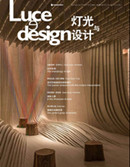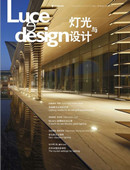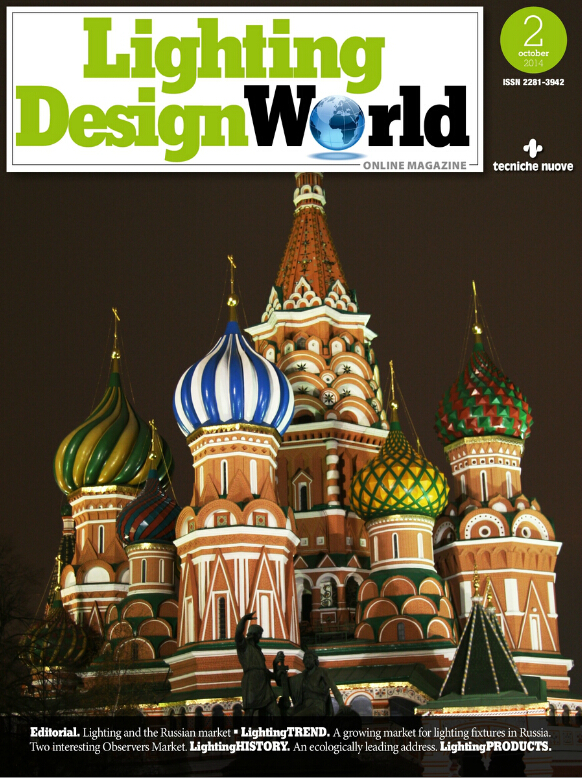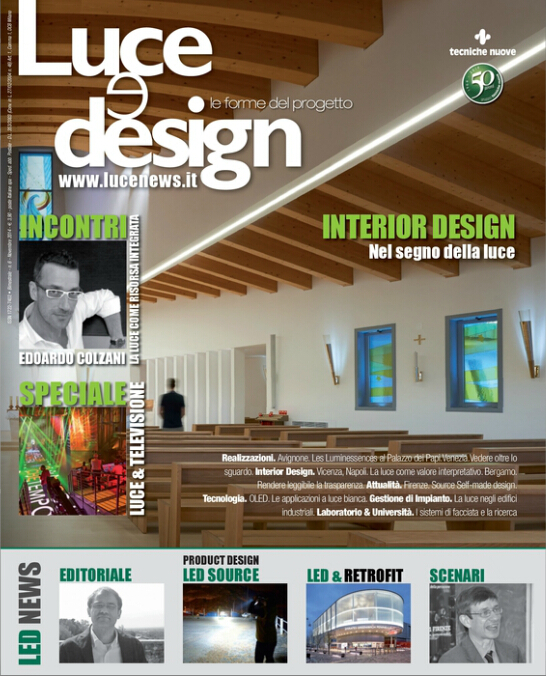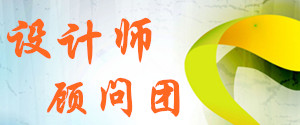文:马丝摩·维拉
by Massimo M. Villa
我们拜会了这位世界上最重要的灯光设计师之一马克·梅杰。他和乔纳森·斯皮尔斯一起在伦敦和爱丁堡建立了 S+M 设计室。在此,他们讲述了英国灯光与设计的发展历程
您的专业和经验是怎样从灯光照明行业和市场磨练出来的?
当我第一次进入灯光设计行业时,这一行业在英国并不常见,一个完全独立的、付费的建筑灯光设计服务,这几乎是闻所未闻的。当时大部分建筑环境的照明设计由顾问电气工程师或照明配件供应商来进行。鉴于后者提供的服务都是免费的,客户不大愿意付费去找灯光设计师提供照明设计,但对一些客户来说 “世界上没有免费的午餐” ,则认为只有专业灯光人士结合其他设计专家比如建筑师,景观设计师和室内设计师在一起时,项目才能真正实现它的价值。但这并不是说很容易说服客户雇用我们。恰恰相反,我们很努力地游说和教育客户,专业灯光设计师的价值,以及我们的服务和什么是正确的方法。照明设计师因此应运而生,虽然经历过困难,但我相信经历这样的过程之后我们会变得更加强大。
我们觉得您设计理念和其他国际灯光设计专业人士一样,坚决反对光过度使用灯光照明,从而适度保留黑暗的意识。您对此怎么看?
我们一直认为,光明和阴暗之间的对比和对话在建筑物的视觉和情感表达中起重要的作用。有时候,这种对比是通过极端的光明与黑暗来体现的,在其他场合,二者的关系则会有一种更为微妙的平衡。一个很好例子是,在绘画界,可以很容易看出我们着重强调的部分。例如,艺术家卡拉瓦乔在画中运用明暗对照法技巧,形成明与暗的强烈的戏剧冲突。而对于另外一位具有浪漫人文主义的画家维米尔,运用柔和,漫射的光营造阴影从而使他的作品具有复杂的意义。
当我们照亮某个建筑物或是某个环境,我们意识到通过选择明暗程度,我们可以用类似的方法将建筑物赋予新的含义。所以我们很慎重使用光的数量和明暗的程度,以便我们能够满足项目在功能与美学方面的需求。
您研究的重点是强调人在城市框架中有更突出的作用,这在您的项目中寻求灯光设备及照明方式达到一个完美的结合。为了实现这一目的,您使用的最重要的设计工具是什么?
一个设计师在解释他们经历的过程时,其中危险的一点就是被认为是追求成功的万能药方。鉴于此,可以公平的说,在过去的15年中,我们发明了一些具有某些主题的城市照明的方法,通过使用灯光可以让人们体会到白天无法体会的一些事物。
当我们在黑暗中再次显露出某些在白天我们无法感知的、或无法理解的事物的状态,细节或材料时,灯光显示出强大的威力。比如说,当在研究一个历史事件,提及等级制度的形式和相关细节,就可以从一个特殊的角度提供一个叙述详尽的故事。在伦敦的Kings Cross, 我们设计了灯光的总体规划,这个规划是为了重建之前具有历史意义的堆货场。在那里,我们决定只点亮原始的工厂建筑,因为它们都很漂亮,这些建筑位置,从视觉和功能上表达得很清楚。之后我们建议那些新兴的、现代办公楼,住宅和零售商大楼不点灯以便形成鲜明对比,我们相信,通过这么做,不仅这些历史建筑更为明显,而且保留了这个作为堆场的历史遗址的回忆。伴随着历史,我们也探讨价值观,以及夜晚使用艺术的方式。
我们的第二个观点是帮助客户了解,一个好的灯光设计像其他设计一样,是在各种冲突中实现一个合理的平衡。在建筑领域,室内设计师和其他相关行业,他们的职能也许是没有必要讲的,但是在灯光设计行业却不同,因为关于好和坏有许多不同的观点。通过帮助人们了解灯光不仅仅是提供“勒克斯”水平,而是尽可能地解决不同性质的操作问题:如何建立标志,提供安全和支持,这些需求,都是需要在紧张的财政预算环境中实现。看来是显而易见的,但我们从来不觉得奇怪,在客户里,只有少数股东意识到我们的价值是很重要。在一定程度上,每个人对某一部分或多或少有自己的偏见。比如环境保护者总是想尽可能地节约能源,但是他们考虑到了美学方面的要求了吗?安全顾问总是只关心灯的数量以及它如何与闭路电视摄像机工作,客户和成本顾问只是在乎到底花多少钱?实际上灯光是为了公共场所和建筑的使用者而设计的,而这些人通常不参与上述的对话。我们的角色是解决这些冲突,设计出的灯光既特殊又可以满足客户以及最终使用者的需要。
在灯光设计师还没有从体制上发挥其应有的作用时,您认为灯光设计在都市中应该发挥怎样的作用?正如现在所说 – 伦敦已经是过度照明,是不是照明设计太少的结果?
我们相信灯光设计师,在夜晚为创造城市环境的美好未来发挥着日益重要的作用。现在伦敦的许多重要工程都得益于灯光设计作为项目团队的一部分参与其中。值得注意的是规划机构和其他部门从一开始就试图保证灯光合理的被使用,特别是在一些较为敏感的地方,像位于河边的高塔。唯一的问题就是,如果没有正式的认可或经过专门就从事设计工作,我们担心客户和政府部门无法区分有经验和设计背景的专业照明人士,和那些将城市照明简单的看成其收入来源的一部分的公司。
很显然自从2008年金融危机以来,财政支出似乎比实际能力显得更为重要,结果是有一两个照明规划错失良机,随着一些随意的建筑照明的想法以及普通的照明水平,照明设计的水平变成略高于术语表。
当然在英国和海外都有许多优秀的灯光设计师。在英国我们喜欢像Jason Bruges和United Visual Artists这样有创造力的艺术人才。在国际上我们非常尊敬诸如Roger Narboni 和Kaoru Mende这样的灯光设计师-他们在城市环境中的灯光设计中运用了很多技巧。这些设计师的作品持续的为国际标准提供了一个很好的基准点。
在我国还没有经常使用总体规划,请问能使用总体规划的工具,能为有需要建立和/或恢复市区清晰路径的提供具体解决方案吗?
灯光在现代都市的夜晚是一个非常明显的有用的工具。在城市的发展历程,几百年以来人类一直努力缩短黑夜延长白天时间。问题是,为什么我们总是试图做到这一点?由于人们对黑暗的原始恐惧吗?或者是我们每天都有许多事要做,所以我们不能让夜晚阻止我们的工作和休闲活动?
在过去的几百年间,我们看到了照明技术为了延长白天和提供方便、清洁、便宜的灯光而不断发展和成熟。但是,只有当爱迪生和斯旺的照明革命,才使我们可以廉价,方便,自由的使用灯光并在夜幕降临后可以用光照亮城市的每一个部分。在我们看来,在20世纪这种不断的追求以便创造更多的光 – 仅仅是因为我们能够做到;在新时代,我们应该考虑如何可以做的更多以便按照我们的需求获得更多的灯光。
对于灯光设计师,这是一个很好的机会,因为现在社会明白需要一个有远见的团队共同合作战胜黑暗。从这个意义上来讲,设计师要具备能力和经验来了解实际需要多少灯光,使用者是谁,什么时候,以及需要多长时间。从经济、社会、以及环境来讲,灯光设计师已经超越了仅仅辅助剧院和工程,而成为了一个独立个体。唯一的问题是现在缺乏对专业团队的培训,专家自称会兑现承诺,或是客户和委托机构未能实现其重要性。
关于灯光设计在未来应用,你认为我们在什么领域将看到更多的新技术解决方案的发展,在哪个应用领域灯光设计会大幅增加?
一直以来,我们坚信的是了解光源是我们工作的本质所在。所以我们是有责任了解在我们领域所发生的最新的、令人振奋的发展情况。这包括不断发展的 LED 和 OLED,及照明材料的不断发展,同时照明控制的重要性日益增加。在这次采访中我曾经提过,对于像我这样处理了不到六种光源的照明设计师而言,未来还有无限的可能性。由于未来的建筑会结合新的照明技术,传统照明装置也许会显得过时,这意味着我们未来要学习要更加谨慎地处理照明。
What is the context and the lighting market condition from which the professional experience of your practice has emerged?
When I first came into lighting design it was very unusual in the UK, almost unheard of, for someone to be offering architectural lighting design services on a fully independent, fee paid basis. At that time most lighting design for the built environment was either carried out by the consulting electrical engineer or by the manufacturer who was supplying the light fittings. Given that the latter always offered that service for free it may have seemed impossible that clients would prefer to pay for such a service but those that truly understood that ‘there was no such thing as a free lunch’ recognised the considerable value that a highly creative professional could bring to the project when properly integrated with other design professionals such as the architect, landscape designer, interior designer, etc. That is not to say that it was always easy to convince people to hire us. Quite the contrary. It took a lot of hard work persuading and educating the market of the value of what we do and defining the way it should be done – properly. That was the context out of which we emerged and whilst it was a struggle I believe that we are much the stronger for having gone through that process.
We have the feeling that your approach to lighting design, like that of others in the international lighting design community, is firmly opposed to the inflationary use of light, and shows an awareness of the value of conserving darkness. Can you comment?
We have always felt that contrast and the dialogue between light and shade plays a key part in the visual and emotional expression of the built environment. Sometimes this contrast is marked by extremes of light and dark; on other occasions the relationship can be more subtly balanced. A good example to underline what we mean is to turn to the world of painting. The artist Caravaggio bought considerable drama to his paintings by exploiting the contrast between light and shade using his technique of chiaroscuro; whereas the more romantic humanist painter Vermeer, painted soft diffuse light to create a multiplicity of shadow providing complex meaning to his work.
When we illuminate a building or an environment, we acknowledge that by choosing the degree of light and shade, we are also placing a new interpretation on the architecture in a similar way. We are therefore always careful about the amount of light we use and the degree of darkness we retain so that we meet the functional and aesthetic requirements of a project in a balanced manner.
The emphasis you lay on research aiming to enhance the human presence in city frameworks becomes in your projects identification of technical solutions searching for perfect agreement between lighted settings and the various modes of using the settings. What are the most important design tools you use to that aim?
One of the dangers of any designer explaining the process they use, is it may be treated as some of form of infallible recipe for success. Having said that, it is fair to say that over the last 15 years we have developed an approach to urban lighting that consistently comes back to a few themes. Some of these aim to enrich the human experience by employing light to refer to things that might not otherwise be obvious by day.
Light has a tremendous power when seen against the canvas of darkness to signal and reveal forms, details and materials that may not be so readily understood and appreciated during daylight hours. For instance, when working in a historical context, a simple decision to allude to specific hierarchy of forms and details can provide a consistent narrative in a specific direction. We explored this in our work at Kings Cross London, where we developed a light masterplan for the ongoing redevelopment of a former historic railway goods-yard site. There, the decision was made to only illuminate the original industrial buildings – many of which are very beautiful structures – such that their position, visual language and function is made clearer. We then suggested that the new, contemporary office, residential and retail buildings should remain largely unlit to create a contrast. We believe that, by doing this, not only does the site become more legible, but equally, the memory of the former use of the site as a goods yard is retained. Other issues we explore alongside history include communicative values, and the means by which art may be integrated into the night-time experience.
The second set of values that we apply is to help our clients understand that good lighting design like many other design disciplines is based on achieving the right balance between various conflicting forces on the project. In architecture, interior design and many other related disciplines, it is often not necessary to spell this out, but in lighting design because there are so many diverse views of what is good and bad practice it helps to remind people that light is not just about providing the right ‘lux level’, but rather addressing a variety of qualitative and operational issues as diverse as: creating identity, assisting with way-finding and supporting safety and security. All of this needs to be achieved in a sustainable manner working within what are often tight economic constraints. Whilst that may seem obvious, we never fail to be surprised how within the client group, very few stakeholders feel that all these values are equally important. Rather, each has a prejudice towards a certain part of the spectrum. For example, environmentalists will always want to use as little energy as possible but do they worry about the aesthetic outcome? The security consultant is often only interested in the amount of light and how it works with CCTV cameras. The client and cost consultant just want to know how it all can be afforded. The actual people the light is designed for – the public or the building users – are often not present during those conversations. We see it as our role to try and reconcile all of these conflicts to develop a lighting design that is both special and answers the real needs of the client and the people who will experience the final result.
What role, not yet institutionally played by lighting designers, should in your opinion lighting design play within the greater metropolitan areas? What is said nowadays – that London is over-illuminated – is that a result of too little lighting design?
We believe that lighting designers are playing an increasingly important role here in London in creating the future of the city environment after dark. It is true to say that many of the more important projects in the capital now benefit from having a lighting designer as part of the project team. And, it is notable that planning authorities and other regulatory bodies are looking to ensure that lighting is properly planned from the outset, especially when it come to sensitive locations, such as tall towers riverside sites. The only problem is that, given there is no formal recognition or professional training for lighting designers to do this type of work, we worry as to how clients and authorities can discriminate between those that have the experience and background to perform such work, and those who simply see city lighting as another source of income.
It is apparent to us that since the financial crash of 2008, the bottom line has become a more significant factor than the actual ability of a consultant, and as a result there are one or two lighting masterplans that have failed to realise the opportunity they should have, becoming little more than a glossary of lighting terminology, with some tables for lighting levels and some random ideas for lighting architecture thrown in.
Of course there are many great lighting designers both in the UK and overseas. Here in Britain we like the work of the more creative ‘artists’ such as Jason Bruges and United Visual Artists. Internationally we greatly respect lighting designers such as Roger Narboni and Kaoru Mende – who display real skill in handling light in the urban environment. Such designers continue to provide a benchmark for future international standards.
Could the master planning tool, which in our country is still not often used, provide specific solutions for the need to build and/or rediscover legible paths for the urban areas in our cities?
Light is obviously a very useful tool in the modern city after dark. The development of cities shows that man has consistently endeavoured to banish the night and extend the day over many centuries. So, the question is, why have we always tried to do this? Is it due to a primitive fear of the dark? Or there is so much to do each day, that we cannot allow the night to curtail our working and leisure activities? Throughout the last few centuries we saw the gradual evolution of increasingly sophisticated forms of lighting technology that aimed to extend the day and provide light conveniently, cleanly and affordably. But it was only when Edison and Swann revolutionised society with cheap, convenient, and freely available sources of illumination that we were able to light every part of our city from dusk to dawn. It seems to us that during the 20th century this relentless quest to create more light – just because we could – now leaves us on the threshold of a new age in which we may consider that we will be able to do pretty much what we want in lighting terms.
This is a fantastic opportunity for the lighting designer because for the first time society understands that it needs visionary teams to work together to champion the role of darkness. By this we mean designers whose entire philosophy and experience equips them to suggest how much light is actually required in a given context, for whom, when and for how long. In examining the success of cities after dark more broadly in economic, social and environmental terms, lighting design has moved beyond being merely an adjunct to theatre or engineering, and has become a separate entity in its own right. The only thing that will hold it back now is a lack of education among the professionals, who profess to deliver on its promise, or the failure of clients and commissioning bodies to realise the importance of its role.
In terms of future application scenarios for designed light, in what domains do you think we will witness increased developments of new technology solutions, and what will be the application fields where the presence of designed light will increase mostly?
We have always believed that knowledge of the source of light is at the root of what we do. We therefore have a duty to keep abreast of the new and exciting developments that are taking place in our field. These include the ongoing evolution of LEDs and OLEDs, the development of new and exciting materials that work with or react to light and the increasing importance of lighting controls. I have implied earlier in this interview that the future possibilities seem to be limitless to someone like me who started out as a lighting designer dealing with less than a half dozen usable sources. The fact that traditional light fittings may be made obsolete in the future by buildings that incorporate new lighting technologies into their very fabric, means that we will need to learn to look at the way that light is handled even more carefully in the future.
图:灯光设计师马克•梅杰
Picture : Lighting designer Mark Major



